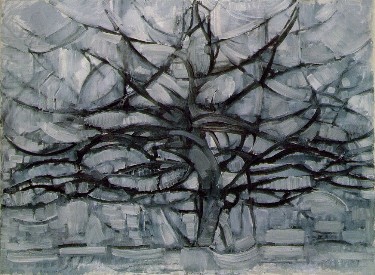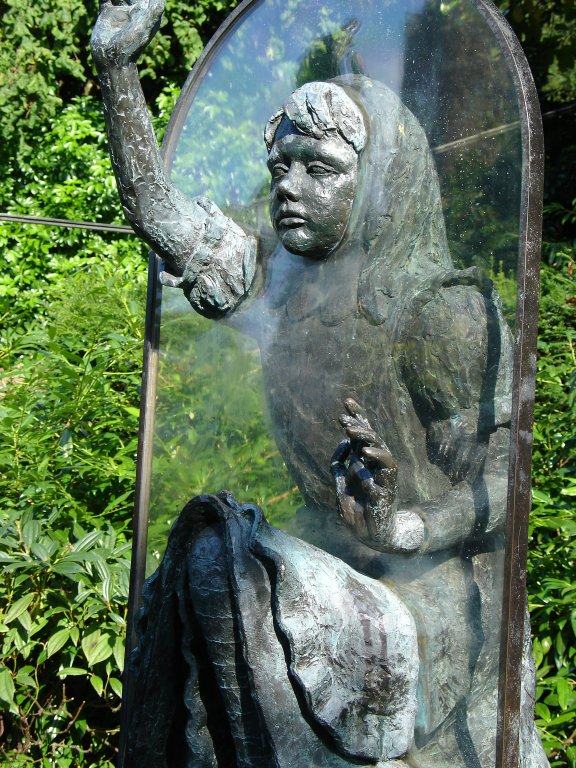Serendip is an independent site partnering with faculty at multiple colleges and universities around the world. Happy exploring!
Imagining Curricula...
1.
2. 
3. 
4. 
5. 
Finding the Body
As I rapidly make my way through my fourth year of college, I’ve begun to think about my educational experience in its entirety, rather than its pieces. A result of this activity, I’ve been grappling with a central problem. I feel that I’ve been working a lot with theory, with words and language and thought. While I, personally, enjoy this kind of learning, I feel that this kind of intellectual exercise is in some ways an act of displacement, of pulling back from the world and into my head; I am reminded of Acker’s attempt to locate the body. Within the discipline of gender studies specifically, I feel that in some respects my education has brought me to a much higher plane of understanding and in other ways it hasn’t had much of a tangible effect. To qualify that statement, I would like to recall McIntosh’s 5-tiered system of curricular revision. I feel that many of my classes have fit comfortably within “Stage 3” perhaps bridging on “Stage 4.” That is to say, my classes have identified and diagnosed the dilemma of gendered politics; they have acknowledged that there is an implicit and problematic existence of gender within, arguably, all social systems. That being said, I don’t think that any of my classes have ever taught me what to do with that knowledge. I believe that in order to reach “Stage 5” of McIntosh’s idealized system, we must actively work to uncover what’s next. We must bridge thought with action, taking what we’ve learned in the classroom and applying it to the world outside. We must make our education relevant and I believe that this can be achieved by drawing on the skills of everyone in the classroom, allowing each person to speak to their area of interest and propose a project of active change. My proposal for the rest of the semester would ideally combine the intellectual work that we are doing in the classroom with a material component, grounding our study in the physical world around us.
Identifying the underlying presence of masculine or feminine elements within our daily existence is no easy task and I would certainly not claim it as such. I think that before any kind of change can be enacted, we must first identify implicit structures of gender within our culture. I believe that this was the underlying task of the first part of our interdisciplinary GASworks class. In Biology, we unraveled the scientific history of “naturalized” gender with the help of Joan Roughgarden’s text, Evolution’s Rainbow. We learned that gender categories are not an inherent fact of the biological kingdom, that actually many organisms bend or break the gender binary, that perhaps the existence of the binary has social rather than biological roots. Therefore, we moved on to explore the discipline of social sciences. Using Sherry Ortner as our guide, we began to think more intensively about the existence of social categories of gender. We expanded that conversation into the realm of the humanities, thinking about the ways in which gender intersects with language. We looked at the ways in which literature itself has the potential to actively challenge the way we conceptualize these categories.
As students in the classroom, we have been learning how to look at gender as reflected through various disciplines, acquiring the tools to identify these implicit structures and analyze how these structures are working. Now that we have the basic tools, I feel that as a class we should continue to actively deconstruct these writings and stories, whether in the Natural Sciences the Social Sciences or the humanities, and ultimately reclaim them. This idealized notion of reclaiming may seem far-fetched but I think that we can begin to see it working in all of the texts that we have read for class. Every author that we have read is working to reshape the traditionally masculine cannon, but just reading the work that others have done is not enough. Therefore my proposal for the classroom component of the remainder of the semester would be to challenge and question our own texts, to keep the conversation moving progressively forward.
I think that this progression can be accomplished in a variety of ways. Since this is an interdisciplinary course, I think that is it important that we continue to fluctuate through many areas of study. That being said, my area of knowledge is pretty firmly rooted in the humanities and the arts. Like Acker, I am fascinated about how representation and signification through cultural texts can influence how we understand ourselves and others. I understand, though, that not everyone in the classroom thinks like me. I think that our strength as a class lies in the fact that we do come from different areas of study. I think that each person in the class should pick a text from their own area of interest, be it humanities, social sciences, or natural sciences. These texts should present a kind of central conflict with gender and we can discuss as a group how that conflict manifests itself and how it could potentially be resolved.

For example, I am particularly interested by the ways in which gender manifests itself in children’s literature, fairy tales, and, within the last few decades, Disney movies. Sure, Disney is not the most academic of subjects, but I think that these forms of cultural media have a very formative influence on a child’s, and subsequently an adult’s, gender identity. This presents a kind of central problem to discuss in class: how do we see gender manifesting itself in a movie like “Beauty and the Beast” or “Aladdin”? If these movies present gender problematically, what do we do about it? Should we stop watching these movies (and yes, I will admit that I still watch Disney on occasion)? Should we show our children these films? Are these films ultimately harmful? Is there a way that we can “reclaim” these representations of gender? I think these are questions of relevance to our daily lives and they also relate to Acker’s exploration of Through the Looking Glass and greater questions of how we learn gender from a young age.
So there’s an example of the kind of text that I would use for my day of class. I propose that each of us should get our own day to explore the topics that we see as relevant and interesting to us. If there are too many of us, then we could join up in pairs or groups. I don’t want these to be like presentations or “teaching” days – I personally hate public speaking and I tend to get very nervous before I have to formally present a project of mine. I simply mean to offer up these classes as a space to introduce an interesting problem, grounded in a kind of visual, written, or spoken text, and work out that problem as a class.
In addition to our work in the classroom, I believe that we should also add an active component to our studies. To provide a little background to that statement, I will say a little bit about my experiences learning about gender and sexuality outside of the classroom. Sure, I’ve seen the ways that gender manifests itself in my own day-to-day experiences, but I also have witnessed the powerful influence that gender holds in other people’s lives when I worked with specific non-profit organizations. One of the most formative experiences for me took place while I was working with an advocacy agency for women living in violent environments. At this organization, I talked with many women who were in relationships that severely disempowered them, often to the point where they needed crisis planning and shelter. These women were rich and poor, young and old, of all races and ethnicities. While each client was individual and distinct, the way in which they internalized their sense of inferiority and weakness was consistent. The clients that entered counseling, or even just occasionally called to talk about their problems, rigorously worked to reinvent their sense of agency and power. This process was a difficult one, and one that sometimes failed. I witnessed many women returning to abusive relationships for a variety of reasons. I think back now and I wonder: if these women had read Sherry Ortner or Joan Roughgarden would they still be victims of domestic violence? Would they still feel powerless? I have to say that I don’t know the answer, but part of me feels that believing in the transformational power of texts themselves is just naive. There is a part of life that lies outside of the classroom, outside of the intellectual exercises. Even if we, as individuals, have come to a better place of understanding our own gender and sexuality, how can we use that knowledge to better the world around us?

I suggest that in addition to our work with texts, each student would propose their own personal project to enact change. This project could be activism, social service, pedagogical, artistic representation, or something entirely different. Not only would these individual projects allow us to enact change within our own interests and using our own strengths, but I also think that hearing about the diverse projects within the class itself would be a great learning experience. Diversity is a tool that can be used to fight the problem of categorical repression that we have been talking about for the first weeks of class. Movement and multiplicity is what keeps us alive, from being stuck and named and “being in a dead world” (Acker, 79). I feel that consistent activity to undermine certain repressive structures is how that movement continues.
These projects could be big or small, as long as they were feasible to begin within the second half of the semester. People could work within their disciplines, for instance, as an English major, I could reclaim a poem from Junior Sem (in the traditionally male cannon) and explain my interpretation to my class, or people could work outside of the categories of academia. Those who are interested in social service could volunteer at a clinic or an organization. For someone who babysits or works at a daycare, maybe a project could be to find small ways to talk with children about gender. Or perhaps a project would be to adjust the way that we gossip among our friends, thinking more critically about the use of certain words like “bitch” or “slut.” For the more artistically inclined, maybe someone could paint a picture or write a story that challenges our previous conceptions of gender and sexuality and opens up further dialogue. There are many ways that we can begin to shift the way our society operates around us so that we become agents rather than merely passive recipients. I think that these projects would further our understanding of gender representations and use our knowledge in new and productive ways.
I’ve spent a lot of time inside my head in the past few years, theorizing and articulating and contemplating and analyzing, and I think I’m getting a little antsy. Maybe this is a manifestation of “what next after college?!” anxiety. Whatever it is, I feel that I’ve spent a lot of time thinking and a lot less time figuring out just what to do with all those thoughts that are swimming around inside my head. I would love to use this class as an opportunity to begin answering that question – learning how to transform thought into action.
Images: trees - 1. http://farm2.static.flickr.com/1048/731130267_ffdc041e93.jpg?v=0, 2. http://www.soho-art.com/shopinfo/uploads/1044456495_large-image_34_apple_tree_in_flower_1912_lg.jpg, 3. http://www.anthroposophie.net/bilder/mondrian_gray_tree.jpg, 4. http://www.znanje.org/i/i27/07iv09/07iv0927/Mondrian-red-tree.jpg, 5. http://www.growingfree.com/tree.jpg Little Mermaid: http://api.ning.com/files/ZjCHSB2aNBuq9kqRSZKz5wadaxGtFP3gw0i3oNF*fJIyU1nZ3VS6tw-uE62KNJgIUnM7ASwCkwV3gR6ezdpVWu1m7ZblNP*-/ariel1.jpg Statue: http://home.clara.net/heureka/art/alice02.jpg


